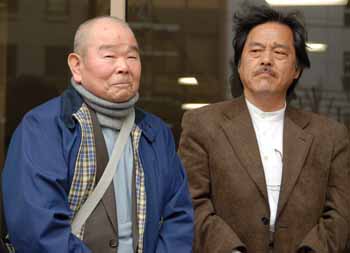 |
|
Mitsuaki Nagao (left) chatting with his lawyer after giving evidence in court (6 April 2006)
|
Mitsuaki Nagao was exposed to radiation as a result of his work at nuclear power plants. He contracted a form of bone marrow cancer known as multiple myeloma and became the first person in Japan to be awarded worker's compensation for a radiation-related illness other than leukemia (
NIT No.99, March/April 2004).
Over a period of four years and three months (October 1977 to January 1982), while working on piping and as a work supervisor at nuclear power plants, including Tokyo Electric Power Company's (TEPCO) Fukushima I plant, Nagao received an accumulated radiation exposure of 70 milli-sieverts. Changes in his physical condition appeared after he retired in 1992, and in 1998 he was diagnosed as having multiple myeloma.
After that, Nagao came to think that his condition was caused by his exposure to radiation. He found supporters and applied for worker's compensation. The Ministry of Health, Labor and Welfare responded by establishing an expert committee to investigate the link between radiation exposure and multiple myeloma. In January 2004 the Tomioka Labor Standards Office (Fukushima Prefecture) concluded that radiation exposure while working at nuclear power plants was indeed the cause of Nagao's condition and awarded him worker's compensation.
Before he was awarded worker's compensation, Nagao joined the Yokohama City Union, a labor union that will accept individual members. (Most Japanese unions are company-based.) He demanded that his direct employer, Ishikawajima Plant Construction Co. Ltd., and prime contractor, Toshiba, publish information about radiation exposure in the places where he worked, but they said they didn't have this information. After being awarded worker's compensation, he demanded that both companies pay damages, but they refused to negotiate with him on the grounds that he had retired from Ishikawajima and that he was not an employee of Toshiba.
Nagao concluded that TEPCO was obliged to compensate him under the Law on Compensation for Nuclear Damage (Nuclear Damage Law), but TEPCO rejected his demand out of hand. Since the company refused to negotiate in good faith, he was left with no alternative but to take the matter to court. His supporters established the "Mitsuaki Nagao Support Group for the Nagao versus TEPCO Nuclear Compensation Suit" and in October 2004 he sued TEPCO under the Nuclear Damage Law.
Unjust Verdict Rejects Multiple Myeloma Diagnosis
On 23 May 2008, the Tokyo District Court rejected Nagao's case on all counts. Judge Hidetaka Matsui rejected the diagnosis itself, saying that Nagao did not suffer from multiple myeloma at all. He went on to say that even if Nagao's condition was multiple myeloma, there were too few cases to draw a cause-effect relationship with radiation exposure.
The verdict showed clearly how the judicial system shows bias towards the nuclear industry, because of its "national policy" status, even giving it a higher priority than human health and life. One is forced to ask the question, is the judiciary really independent in Japan?
Background of the Case
Under the Nuclear Liability Law, nuclear power companies are held responsible regardless of fault, so TEPCO's negligence was not an issue. Since the Ministry of Health, Labor and Welfare had already accepted the cause-effect relationship between radiation exposure and multiple myeloma, it was presumed that the key issue would be the amount of compensation to be paid.
However, the defendant, TEPCO, chose to fight on all fronts. It stopped at nothing, no matter how ugly, to avoid paying compensation. Its main three arguments were as follows: 1) there is no cause-effect relationship between radiation exposure and multiple myeloma; 2) even if a relationship exists, the period during which Nagao was entitled to claim has elapsed; 3) Nagao's condition is not multiple myeloma.
Over half of the three-year trial was taken up by consideration of four submissions presented by TEPCO. These submissions, which claimed that Nagao's condition was not multiple myeloma, were written for TEPCO by multiple myeloma specialist Dr Kazuyuki Shimizu, a professor at Nagoya University Graduate School of Medicine.
Dr Shimizu's submissions were a mass of distortions. They used multiple diagnostic standards arbitrarily, distorted Nagao's medical history by selective quoting and were inconsistent with each other and with his own published articles. According to Dr Shimizu, Nagao suffered from "solitary plasmacytoma", as well as from "monoclonal gammopathy of undermined significance", even though the symptoms of these conditions are clearly inconsistent with Nagao's symptoms. Nagao's supporters took on the challenge of studying these complex technical documents and pointing out the inconsistencies and distortions in Dr Shimizu's submissions.
Hearings finally ended on 7 December 2007. On that day, Mitsuaki Nagao submitted a final statement to the court which said, "I am too sick to express my views in person before the court, but I appeal to the judge to hand down a decision which sheds light on the darkness of Japan's nuclear power industry." Thereafter his condition deteriorated rapidly and on December 13 he passed away at the age of 82.
At the wish of Nagao's family, on June 5 his support group appealed to the Tokyo High Court.
In April 2006, responding to questions in court, Nagao had described in detail the terrible conditions of nuclear workers. One sensed his deep concern for the current generation of workers, who work in fear and anxiety. After winning his worker's compensation case, Nagao said, "Many nuclear workers are exposed to radiation. Acceptance of my worker's compensation case, for a condition that arose many years after I had finished working, will give encouragement to other workers. I want to help other workers while I am still healthy enough to do so."
While suffering from his disease, Mitsuaki Nagao fought for justice to the very end. We would like to carry on the battle for him.
Mikiko Watanabe (CNIC)

